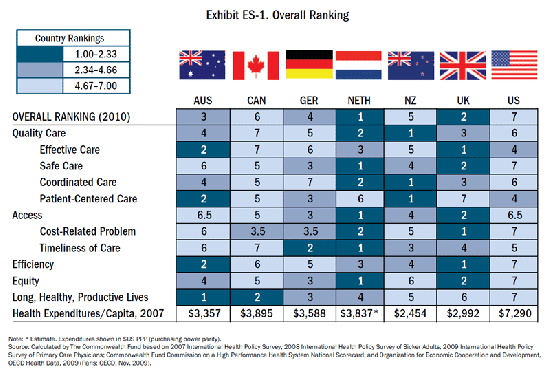Mirror, Mirror on the Wall: How the Performance of the U.S. Health Care System Compares Internationally, 2010 Update
Overview
Despite having the most costly health system in the world, the United States consistently underperforms on most dimensions of performance, relative to other countries. This report—an update to three earlier editions—includes data from seven countries and incorporates patients' and physicians' survey results on care experiences and ratings on dimensions of care. Compared with six other nations—Australia, Canada, Germany, the Netherlands, New Zealand, and the United Kingdom—the U.S. health care system ranks last or next-to-last on five dimensions of a high performance health system: quality, access, efficiency, equity, and healthy lives. Newly enacted health reform legislation in the U.S. will start to address these problems by extending coverage to those without and helping to close gaps in coverage—leading to improved disease management, care coordination, and better outcomes over time.
Executive Summary
The U.S. health system is the most expensive in the world, but comparative analyses consistently show the United States underperforms relative to other countries on most dimensions of performance. This report, which includes information from the most recent three Commonwealth Fund surveys of patients and primary care physicians about medical practices and views of their countries' health systems (2007–2009), confirms findings discussed in previous editions of Mirror, Mirror. It also includes information on health care outcomes that were featured in the most recent (2008) U.S. health system scorecard issued by the Commonwealth Fund Commission on a High Performance Health System.
Among the seven nations studied—Australia, Canada, Germany, the Netherlands, New Zealand, the United Kingdom, and the United States—the U.S. ranks last overall, as it did in the 2007, 2006, and 2004 editions of Mirror, Mirror. Most troubling, the U.S. fails to achieve better health outcomes than the other countries, and as shown in the earlier editions, the U.S. is last on dimensions of access, patient safety, coordination, efficiency, and equity. The Netherlands ranks first, followed closely by the U.K. and Australia. The 2010 edition includes data from the seven countries and incorporates patients' and physicians' survey results on care experiences and ratings on various dimensions of care.
The most notable way the U.S. differs from other countries is the absence of universal health insurance coverage. Health reform legislation recently signed into law by President Barack Obama should begin to improve the affordability of insurance and access to care when fully implemented in 2014. Other nations ensure the accessibility of care through universal health insurance systems and through better ties between patients and the physician practices that serve as their long-term "medical homes." Without reform, it is not surprising that the U.S. currently underperforms relative to other countries on measures of access to care and equity in health care between populations with above-average and below-average incomes.
But even when access and equity measures are not considered, the U.S. ranks behind most of the other countries on most measures. With the inclusion of primary care physician survey data in the analysis, it is apparent that the U.S. is lagging in adoption of national policies that promote primary care, quality improvement, and information technology. Health reform legislation addresses these deficiencies; for instance, the American Recovery and Reinvestment Act signed by President Obama in February 2009 included approximately $19 billion to expand the use of health information technology. The Patient Protection and Affordable Care Act of 2010 also will work toward realigning providers' financial incentives, encouraging more efficient organization and delivery of health care, and investing in preventive and population health.
For all countries, responses indicate room for improvement. Yet, the other six countries spend considerably less on health care per person and as a percent of gross domestic product than does the United States. These findings indicate that, from the perspectives of both physicians and patients, the U.S. health care system could do much better in achieving value for the nation's substantial investment in health.























